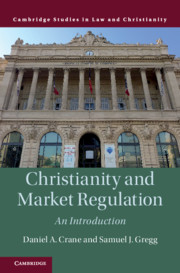Book contents
- Christianity and Market Regulation
- Law and Christianity
- Christianity and Market Regulation
- Copyright page
- Contents
- Contributors
- Acknowledgments
- Introduction
- 1 Christianity and the Morality of the Market
- 2 The Common Good and the Role of Government in Regulating Markets
- 3 Public Choice Theory and Interest Group Capture
- 4 Christianity and Antitrust
- 5 Christianity and Corporate Purpose
- 6 Is Entrepreneurship Christian?
- 7 Subsidiarity and the Role of Regulation in the Financial Sector
- 8 Christianity and Bankruptcy
- 9 Patents, Access to Health Technologies, and Christianity
- 10 Price Controls and Market Economies
- Index
2 - The Common Good and the Role of Government in Regulating Markets
Published online by Cambridge University Press: 18 June 2021
- Christianity and Market Regulation
- Law and Christianity
- Christianity and Market Regulation
- Copyright page
- Contents
- Contributors
- Acknowledgments
- Introduction
- 1 Christianity and the Morality of the Market
- 2 The Common Good and the Role of Government in Regulating Markets
- 3 Public Choice Theory and Interest Group Capture
- 4 Christianity and Antitrust
- 5 Christianity and Corporate Purpose
- 6 Is Entrepreneurship Christian?
- 7 Subsidiarity and the Role of Regulation in the Financial Sector
- 8 Christianity and Bankruptcy
- 9 Patents, Access to Health Technologies, and Christianity
- 10 Price Controls and Market Economies
- Index
Summary
The common good is a term used in different ways in different contexts and, depending on the context, can be defined aggregatively or holistically. In economics, notably welfare economics, the common good is typically defined aggregatively. That is, the whole or common good of a group of people is determined by aggregating the good enjoyed by each of its individual members. In this conception, the common good can be represented by a social welfare function specifying how the economic welfare of a society is comprised of the levels of economic welfare enjoyed by its constituent individuals. This device is utilitarian in concept and indicates how social welfare rises or falls with increases or decreases in the welfare of individual consumers, where welfare is defined in its narrow economic sense to depend exclusively on the consumption of material goods and services. For the economist, then, the relationship between the common good and government regulation of markets consists in identifying circumstances in which government regulation alters the economic welfare of individual consumers in ways that raise social welfare as measured by the social welfare function.
- Type
- Chapter
- Information
- Christianity and Market RegulationAn Introduction, pp. 27 - 43Publisher: Cambridge University PressPrint publication year: 2021

